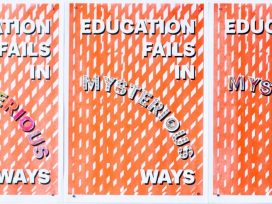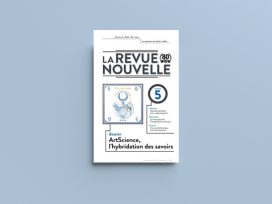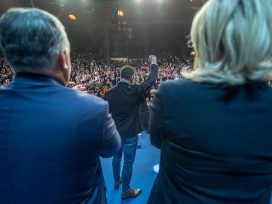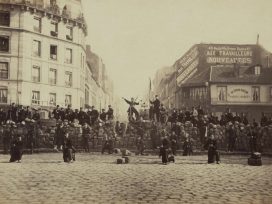Even though Vilnius there are fewer than 200 kilometres separating Vilnius from Minsk, it is not so easy to discuss Belarus and its culture from the perspective of the Lithuanian capital. On the invitation of the Lithuanian government, the European Humanities University (EHU) was transferred to Vilnius in 2005, and today is attended by over 1500 Belarusian students. While this has given rise to closer academic contacts, a more profound understanding of developments in the cultural life of our neighbouring country is still lacking. For the most part, we learn about Belarus from the media, rather than from what we’ve been told by acquaintances – and we ourselves have no new information to share either. Belarusian cultural events are very rare in Lithuania. One example was the cultural platform KultFlux, which included the Viliya-Neris Live concerts by Belarusian music groups, held in 2008. These concerts not only gave the public an opportunity to hear and become acquainted with contemporary music – mainly underground and experimental – from Belarus, but also enabled the musicians to meet a real audience. Thanks to these concerts, the students of the EHU were able to hear and see bands that many didn’t even know existed. On the evenings of these concerts, the KultFlux platform became a small piece of Belarus. For the first time, I appreciated how many young people from Belarus study in Vilnius, and how important such events are to them.
The situation with exhibitions is not much better. In 2009 an exhibition of Belarusian art entitled “Vilnia/Vilnius and Belarusian artists in the twentieth century” (curated by Tatsiana Bembel) was held at the Arka Gallery. At the Art Vilnius ’09 international contemporary art fair, attended by more than 100 galleries, contemporary art from Belarus was represented by two galleries (Podzemka and Lasandr-Art). Individual Belarusian artists also took part in exhibitions held by the Contemporary Art Centre: thus, Artur Klinau participated in the “Centre of Attraction” (Traukos Centras) Baltic Triennial of International Art in 2002, and work by Igor Savchenko was shown at 24/7: Wilno-Nueva York (24 hours) in 2003. The recent exhibition “A Door Opens? Belarusian Art Today”, running from November 2010 to January 2011, was the first major Belarusian contemporary art exhibition in Lithuania, introducing about twenty artists and their work. According to curator Kestutis Kuizinas, the project was intended to set in motion discussion on the discourse of Belarusian contemporary art and its development.
However, according to visual culture and film researcher Almira Usmanova, professor at EHU, “individual artists such as Klinau or Savchenko, who are known in one way or another, are completely isolated – they themselves have never joined the critical context or international networks where large conceptually-loaded joint projects are undertaken. There are also many other factors affecting Belarusian art: from the lack of foreign language knowledge to the inability to formulate one’s vision in conceptual terms.” Another of the curator’s aims – to give Belarusians themselves an opportunity to examine the art of their own country as if from outside – sounds more realistic. Yet so long as there is no clear idea at the domestic level, it is difficult for such an idea to emerge in the neighbouring countries either.
In formal terms, the exhibition displays all the approaches seen in international contemporary art exhibitions: installations in various media, objects, video, photography, and so on. Yet while differences in terms of technique and artistic form may be small, the works are thematically connected, in one way or another, with issues of Belarusian identity and national politics. For example, Lena Davidovich’s video The Book of Ezekiel (2009) uses the Old Testament text as a metaphor for the history of the Belarusian people. The series of photographs Sun City of Dreams by Artur Klinau shows Stalinist Minsk as it was rebuilt after the Second World War to represent a Communist utopia. The city of Minsk, with its buildings, monuments and decorations of public space, whose function is to represent ideology and the ruling power, is also highlighted in other works: Building (2002-2007) by Aleksander Komarov, the work Concrete: the Stuff of Memories (2009) by Igor Peshehonov, and The Path of the Sun (2010) by Marina Naprushkina. These and other artists comment on or document place and its influence on identity and culture.
However, the majority of works in the exhibition present a view of the Belarusian government. In the political works, artists seek to examine painful issues relating to the state, for example they look at the mass media and the “reality” that they help to shape. Alexander Korablev makes use of the most popular sources of information – newspapers – in his collages. In the work Idiot’s Collection (1997-1999), the artist constructs contemporary history using press cuttings, placing celebrities from music, film and fashion, as well as text fragments, alongside politicians. The gradually disappearing text in No News from Belarus (2010) by Alexander Komarov is printed using a fax machine. It is not only an eloquent message to the West, but also an accurate illustration of the present situation. In his work A Clear Choice (2010), Sergei Shabohin comments on the state administration: the visitors are offered the possibility of voting “for or against” on various “socio-political” issues by putting their voting slip into a transparent ballot box, which has two openings. However there is only one compartment, where all the voting slips end up. Marina Naprushkina’s installation Anti-Propaganda Office (2007), meanwhile, tells of the propaganda disseminated in Belarus and the sheer quantity of it by presenting information compiled by the artist.
Also shown at the exhibition are several works analysing the relationship between art, the artist and authority. For example, in the series of photomontages And Nothing Was Left (2009), Sergej Shabohin “destroys”, “burns down” and “closes” those institutions in Minsk where contemporary art is occasionally shown, thus drawing attention to the shortage of such spaces. In the video performance Five Lyrical Songs About Physics. Fifty Artists and Two Art Critics Sing to the Accompaniment of a Piano and Theremin (2009), Maxim Tyminky highlights not only the present condition of the art system, but also the perspectives of the Belarusian artistic community and the public.
The majority of the artists whose work is political or comments on power structures attack the political situation in Belarus in an illustrative manner, applying irony as a painkiller. But there is a lack of critical artistic praxis aimed at articulating and stimulating discussion. The more critical works are by artists living and working outside of Belarus. One third of the participating artists belong to this category. The situation of émigré Belarusian artists is illustrated by the drawings of Oxana Gourinovitch, called Artists and Designers I Know Who Have left Minsk and Artists and Designers I Know who Have Returned to Minsk. The migration of artists is connected not only with the political situation, but also with the economic conditions, the absence of an art market and other causes.
In my view, this exhibition served to confirm what we already knew about Belarus; it seemed to have no desire to change entrenched stereotypical thinking. Certainly, the present situation in the country is brought into focus in the many works that addressing issues of politics, art and the state apparatus, as well as the theme of the artist and emigration; yet the existence of all these issues was known already. There is an absence of more individual, social themes – works expressing an alternative self-confidence. The concerts that took place in KultFlux did give at least an inkling of the existence of a musical subculture in Belarus. The question arises whether the selection of works reflect the choice of the curator or of the artists themselves? We can only hope that the artists taking part in this exhibition will remain in the memory of visitors to the exhibition, will at least in this way fill the yawning gaps in our knowledge of contemporary Belarusian art.






